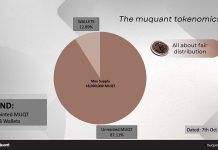An investor that holds a market-moving amount of a cryptocurrency or NFT collection is often referred to as a whale, and whales can make big waves.
Crypto whales are some of the most influential entities in the crypto space. In fact, they are so important that individuals and tools track their activities to predict price movements. Bearing this in mind, let’s look at what crypto whales are and why they are critical components of the cryptoverse.
What are crypto whales?
Simply put, crypto whales are individuals or organizations that own a large amount of a coin or non-fungible token (NFT) collection. The size of the holding has to be large enough to cause a ripple effect on the price of the coin or NFT if the holder sells it all at once.
The threshold of determining whether an altcoin holder is a whale or not depends on the market size of the coin in question. As such, although $10 million worth of BTC is the threshold for identifying bitcoin whales, the minimum requirement may be lower for altcoins, especially those with small market capitalization.
-
Market capitalization, also called a market cap, is a metric that shows the relative size of each cryptocurrency. To calculate the market cap, multiply the current price of each coin by its circulating supply (that is, the total number of coins in circulation).
For example, the market cap of bitcoin at the time of writing this article is around $469 billion when you multiply its price (as of writing, $24,300) by its circulating supply (19.3 million BTC). Because bitcoin has the largest market cap, bitcoin investors need to hold a sizable amount of bitcoin in dollars to be considered whales.
Most other cryptos don’t come close to bitcoin’s market cap, so holders will need far less to be considered a whale. For example, Polygon’s MATIC has a $10 billion market cap while dogecoin (DOGE) is at $9.5 billion, so it would take under $1 million in either to qualify as a whale.
NFT whales are entities that own a large number of NFTs, ideally of the same collection, though often NFT whales own many high-value blue-chip NFTs such as Bored Apes, CryptoPunks, Moonbirds and others. A collector who owns a significant fraction of an NFT collection is an NFT whale. For instance, if a collection consists of 1,000 NFTs, an individual or organization that holds 50 of such NFTs would likely be considered a whale.
Why are crypto whales important?
The sheer size of the holdings of crypto whales means they can influence price trends intentionally or unintentionally. When whales make big moves, they make waves. Let’s look at some of the ways they can cause price swings.
Short-term price spikes
Before discussing the short-term price impact of crypto whales, it is vital to first understand crypto liquidity.
Simply put, liquidity is how easy it is to convert a coin to another cryptocurrency or fiat without experiencing a wild shift in price. When a trader enters a BTC buy or sell order on an exchange, the liquidity status of bitcoin on that exchange will determine how fast it is to match the order, and whether the price of the coin will remain stable.
If there is high liquidity, the exchange transaction will finalize quickly without causing the price to shift significantly. In a case where there is low liquidity, it will take a while to match the buy or sell order and, as a result, the price may shift before the finalization of the trade. Exchanges with high liquidity ensure that all sell and buy orders are matched promptly. In contrast, low liquidity occurs when there is an order matching delay due to deficiencies on either the sell or buy side of trades.
So how does this phenomenon tie into how crypto whales influence the digital asset market?
Like most average crypto holders, whales aim to make more money by increasing the value of their holdings. Because they have access to a large crypto holding, they can influence price trends momentarily by either flooding the crypto market with coins or initiating buying pressure. The two strategies with which crypto whales can cause short-term price swings are as follows:
-
Strategy 1: From the fundamentals of economics, when supply exceeds demand the price is bound to fall. Therefore, a bitcoin whale can cause the price of BTC to fall by selling a massive chunk of his BTC holding. If there is not enough demand for bitcoin, the BTC price will likely plunge sharply. When the price has dipped enough, the whale can start buying BTC at a value lower than his initial selling price. If done right, the whale will end up with more BTC than he began with.
-
Strategy 2: Another basic economic principle that whales can take advantage of says the price of an asset will increase if the demand exceeds supply. With this in mind, an individual or group of bitcoin whales can initiate buying pressure. If the coin supply does not meet this high demand, the price of BTC will surge. This buying spree may trigger the fear of missing out (FOMO) among other traders. As a result, traders will likely start to buy BTC in the hopes that the price will continue to rise. Once BTC surges to the desired price, the whale can start selling at a profit.
In the two strategies highlighted above, the bitcoin whale invokes low liquidity in the BTC market and profits from the imbalance.
Long-term price impact
The activities of whales also denote a shift in crypto market cycles (that is, the recurrence of different stages of euphoria and fear resulting in long-term rise and fall of crypto prices). During a period of a sustained surge in crypto prices, whales often buy more coins to increase the size of their holdings. Once whales begin to sell off a fraction of their holdings, a market crash may be imminent.
The growing adoption of community-based governance anchored by tokens is another reason crypto whales are vital components of the crypto space. A typical decentralized system launches a governance token that distributes voting rights to holders. In most cases, wealthy investors buy up a large portion of these governance tokens to become major stakeholders in crypto projects. Because they own a significant fraction of the governance token, they can easily sway governance voting results in their favor. This is similar to how the votes of large shareholders significantly determine the results of corporate elections.
How to track crypto whales
Bearing in mind the influence of crypto whales, it has become common for crypto participants to track whale activities to determine short-term and long-term price trends.
Crypto whale tracking is possible because the blockchain is a public ledger that documents activities and crypto balances of users. Anyone can track any blockchain wallet address and how much they hold. However, it should be noted it is only possible to determine the real-world identities of the owners of wallet addresses when they publicly reveal this information.
Nonetheless, it is not crucial to figure out the real-world identities of whales. The most important thing is how much the whale’s address holds, how often it moves and the destination of the funds. In particular, the destination wallet is critical information. Below is why:
-
Wallet-to-exchange transactions: When a whale moves a large amount of crypto from self-custody wallets to exchanges, it usually means that the whale is looking to initiate a massive sell-off, which may force the price of the cryptocurrency to drop.
-
Exchange-to-wallet transactions: The movement of large amounts of coins from an exchange to a whale address means the whale is not looking to sell in the near term.
-
Wallet-to-wallet transactions: In some cases, whales prefer to maintain a low profile by ensuring their activities do not cause ripple effects on crypto prices. They do this by executing over-the-counter (OTC) trades. The whale sends coins directly to the OTC wallet and vice versa when buying or selling cryptocurrency.
To track all this information, enter the wallet address of the whale into a blockchain explorer. A blockchain explorer is a database where you can access on-chain historical data.
If manually tracking the activities of crypto whales seems like too much work, here are other ways to do it:
-
Subscribe to on-chain analysis services: Some analytical firms and tools break down live whale transactions.
-
Follow whale-monitoring social media accounts: Certain social media accounts like Whale Alert focus on tracking and reporting the activities of crypto whales.
Note that crypto whales are aware that traders track their transactions. In the hopes of triggering price movements, they sometimes move coins around without eventually executing trades. So keep this in mind and only whale watch as one of many inputs to inform your trading decisions.















